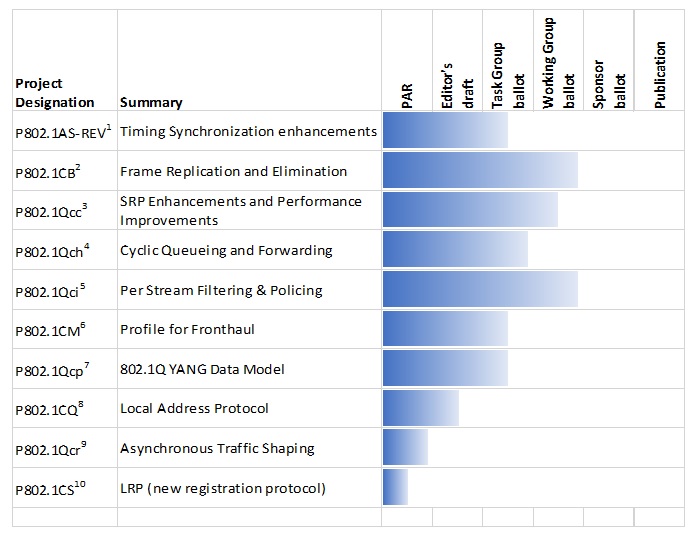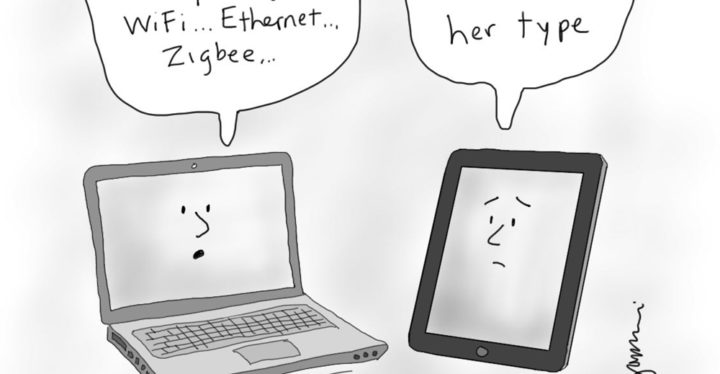Click on the title to read each news item:
Market demands and new technology drive innovation in amendments currently under development in the IEEE 802.11 Working Group
IEEE 802.3 Activities
What’s new in the world of IEEE 802.1 TSN
IEEE 802 5G / IMT-2020 Standing Committee
Market demands and new technology drive innovation in amendments currently under development in the IEEE 802.11 Working Group
 By Dorothy Stanley, Head, Wireless standards strategy, Hewlett Packard Enterprise; IEEE 802.11 positions: IEEE 802.11 Working Group Vice Chair, TGmc Chair
By Dorothy Stanley, Head, Wireless standards strategy, Hewlett Packard Enterprise; IEEE 802.11 positions: IEEE 802.11 Working Group Vice Chair, TGmc Chair
Market demands for throughput, supporting new usage models, technical innovation and changes to regulation are the drivers motivating current IEEE 802.11 standards development. A short news summary of some of the amendments under development is provided below, based on status at the close of the recent July 2016 session in San Diego.
Three task groups: TGah (Sub 1GHz extensions), TGai (Fast Initial Authentication), and TGmc (Revision) are nearing completion of the sponsor ballot development phase for their respective amendments/standard, and are expected to be sent to IEEE Standards Association Review Committee (RevCom) shortly.
- The P802.11ah amendment adds support for operation in numerous sub-1GHz frequency bands, and supports both longer-range WLAN applications and new Internet of Things (IoT) use cases. New technical capabilities include mechanisms to support over 8000 devices per access point, enhanced power saving, narrowband operation, increased transmission robustness, relay mechanisms for further range extension, and the concept of “coloring” to enable a device to distinguish traffic generated within its BSS from traffic generated by other BSSs.
- The P802.11ai amendment provides mechanisms to minimize control traffic, and adds new authentication mechanism to support operation in operator deployments.
- 11REVmc is a revision project, incorporating published amendments since the prior standard was published in 2012. The revision also specifies technical corrections and clarifications to IEEE Std 802.11 as well as enhancements to the existing medium access control (MAC) and physical layer (PHY) functions. For example, recent FCC actions (see http://transition.fcc.gov/Daily_Releases/Daily_Business/2016/db0714/DOC-340301A1.pdf) have made additional millimeter wave spectrum available in the 64-71 GHz bands. Changes have been made to support these new frequencies in the 60GHz PHY (see https://mentor.ieee.org/802.11/dcn/16/11-16-0822-00-000m-extension-of-mmwave-operating-class.docx ). Extensions to the Single Carrier (SC) 60GHz PHY were also made to increase the throughput of that PHY to support data rates above 8 gigabits per second.
Updates on three additional projects: TGak (Enhancements for Transit Links within Bridged Networks), TGax (High Efficiency WLAN), and TGay (Next Generation 60GHz) are described below.
TGak is working to extend IEEE 802.11 media connections so they can be used as transit links in IEEE Std 802.1Q bridged networks. The draft amendment is currently at D2.0, and a D3.0 is expected to be out for Working Group ballot in September 2016, with completion in late 2017. P802.11ak will provide protocols for use in networks including home entertainment systems and industrial control equipment that have both an IEEE 802.11 wireless station capability and a wired IEEE 802.3 Ethernet capability. It enables bridging of both media internal to the network and media offering access to the network.
TGax and is currently working on preparation of an initial D1.0 draft, targeted for the fall of 2016. There are many high density deployments of IEEE 802.11 technology today, and the goal of the 11ax amendment is to provide technology to enable higher per-user throughput and increased power saving at higher ranges. New technologies added in the P802.11ax amendment include Orthogonal Frequency Division Multiple Access (OFDMA) and Multi- User Multiple Input Multiple Output (MU-MIMO).
TGay has competed development of usage models and functional requirements for its 60GHz extensions. The project will define mode(s) of operation capable of supporting a maximum throughput of at least 20 gigabits per second while maintaining or improving the power efficiency per station. This amendment also defines operations for license-exempt bands above 45 GHz while ensuring backward compatibility and coexistence with legacy directional multi-gigabit stations (defined by the IEEE 802.11ad-2012 amendment and P802.11REVmc) operating in the same band.
For further information on the IEEE 802.11 Working group and projects under development, see http://www.ieee802.org/11/ .
IEEE 802.3 Activities
 By David Law, Hewlett Packard Enterprise; IEEE 802.3 Working Group chair
By David Law, Hewlett Packard Enterprise; IEEE 802.3 Working Group chair
A new IEEE 802.3 10 Mb/s Single Twisted Pair Ethernet Study Group was formed to develop a project proposal for 10Mb/s Single Twisted Pair Ethernet including optional power. This activity is being driven by the needs of the Building Automation, Industrial Automation and Transportation industries.
Approval was granted to submit the IEEE 802.3.2 (IEEE 802.3cf) YANG Data Models draft PAR request to the September IEEE-SA New Standards Committee (NesCom) meeting. The scope of this proposed project is to define YANG data models for IEEE Std 802.3 Ethernet. Assuming the IEEE Standard Board receives and accepts a recommendation for approval from NesCom at its subsequent teleconference meeting, IEEE 802.3.2 will become an approved IEEE project on 22nd September 2016.
Approval was also granted to submit a PAR modification request for IEEE P802.3cb. This is proposed because the IEEE P802.3cb project is intended to address a backplane system within a box (enclosure) that contains an array of storage devices interfacing to a backplane, not a stand-alone cable solution. However, the storage devices plug directly into the enclosure’s sub-system, through either a backplane board, or backplane board plus internal cables. To avoid any confusion with a stand-alone cable system, it has been decided to remove the reference to ‘cable’ from the PAR title, scope and need.
The IEEE P802.3ca 25 Gb/s, 50 Gb/s, and 100 Gb/s Ethernet Passive Optical Networks, IEEE P802.3cc 25 Gb/s Ethernet over Single-Mode Fiber and IEEE P802.3cd 50 Gb/s, 100 Gb/s, and 200 Gb/s Ethernet projects all continue to work towards a technically complete draft.
The IEEE P802.3bs 200Gb/s and 400 Gb/s Ethernet, IEEE P802.3bt 4-Pair power over Ethernet, IEEE P802.3cb 2.5 Gb/s and 5 Gb/s Backplane and Copper Cables and IEEE P802.3-2015/Cor 1 (IEEE 802.3ce) Multilane timestamping projects all progressed to initial Working Group ballot, the first stages of the IEEE 802.3 balloting process. The IEEE P802.3bv Gigabit Ethernet over Plastic Optical Fiber (PoF) project proceeded to Sponsor ballot, the second stage in the IEEE 802.3 balloting process. The IEEE P802.3bu project 1-Pair Power over Data Lines (PoDL) continues to progress through sponsor balloting.
Approval was granted to submit both IEEE P802.3bn EPON Protocol over Coax (EPoC) and IEEE P802.3bz 2.5G/5GBASE-T to the September IEEE-SA Review Committee (RevCom) meeting. Approval was conditional for IEEE P802.3bz based on successful completion of an additional sponsor recirculation ballot being conducted in parallel to the submission. Assuming the IEEE Standard Board receives and accepts a recommendation for approval from RevCom, IEEE P802.3bn and IEEE P802.3bz will become IEEE Standards on 22nd September 2016.
What’s new in the world of IEEE 802.1 TSN
 By Craig Gunther, Distinguished Engineer, Harman International Industries
By Craig Gunther, Distinguished Engineer, Harman International Industries
The IEEE 802.1 Time-Sensitive Networking (TSN) Task Group met at the IEEE 802 Plenary in San Diego, California the week of July 25, 2016. For those who are new to TSN it is tasked with defining the next generation of standards that will be built upon AVB (Audio Video Bridging).
The originators of AVB have maintained a focus within TSN that promotes backwards compatibility with AVB while adding capabilities necessary to support new markets. These new capabilities will enrich the existing AVB standards as well as adding features necessary to support Industrial Control, Automotive, Mobile Radio Equipment and Controllers, and others.
During the July face-to-face meeting the TSN Task Group worked on ballot comment resolution for current drafts and reviewed additional drafts that are being prepared for the next round of balloting. New work was also discussed with an emphasis on creating the documents necessary to generate a PAR (Program Authorization Request) to begin the new project. As TSN is always seeking input from sources outside of the IEEE 802.1 organization there was also time spent on liaison work with those groups.
The following figure is a snapshot of the projects TSN is working on and their current status in the development process.

Participating in TSN development
TSN actively invites participation from any individuals, companies, professional organizations and other standards organizations that wish to help define the future of Time-Sensitive Networking. Those interested in participating can find additional information on the IEEE 802.1 Working Group website http://www.ieee802.org/1/.
Public presentation from all 2016 face-to-face meetings can be found here: http://www.ieee802.org/1/files/public/docs2016/.
TSN has a weekly call every Monday at 8AM US-Pacific to discuss general issues, and it continues at 9AM US-Pacific where P802.1AS-Revision issues are discussed. The call is open to all who wish to participate. For more information about the weekly TSN calls and other TSN material please visit the Time-Sensitive Networking Task Group home page at http://www.ieee802.org/1/pages/tsn.html.
References
[1] IEEE P802.1AS-REV Standard for Local and Metropolitan Area Networks – Timing and Synchronization for Time-Sensitive Applications. (http://www.ieee802.org/1/pages/802.1AS-rev.html) [2] IEEE P802.1CB Frame Replication and Elimination for Reliability. (http://www.ieee802.org/1/pages/802.1cb.html) [3] IEEE P802.1Qcc Standard for Local and metropolitan area networks — Media Access Control (MAC) Bridges and Virtual Bridged Local Area Networks Amendment: Stream Reservation Protocol (SRP) Enhancements and Performance Improvements. (http://www.ieee802.org/1/pages/802.1cc.html) [4] IEEE P802.1Qch Standard for Local and Metropolitan Area Networks — Media Access Control (MAC) Bridges and Virtual Bridged Local Area Networks Amendment: Cyclic Queuing and Forwarding. (http://www.ieee802.org/1/pages/802.1ch.html) [5] IEEE P802.1Qci Standard for Local and Metropolitan Area Networks — Bridges and Bridged Networks Amendment: Per-Stream Filtering and Policing. (http://www.ieee802.org/1/pages/802.1ci.html) [6] IEEE P802.1CM Time-Sensitive Networking for Fronthaul. (http://www.ieee802.org/1/pages/802.1cm.html) [7] IEEE P802.1Qcp Standard for Local and Metropolitan Area Networks – Bridges and Bridged Networks Amendment: YANG Data Model. (http://www.ieee802.org/1/pages/802.1cp.html) [8] IEEE P802.1CQ Standard for Local and Metropolitan Area Networks: Multicast and Local Address Assignment. [9] IEEE P802.1Qcr Standard for Local and Metropolitan Area Networks-Bridges and Bridged Networks Asynchronous Traffic Shaping. (http://www.ieee802.org/1/pages/802.1cr.html) [10] IEEE P802.1CS Link-Local Registration Protocol (LRP). This project is currently in PAR (Program Authorization Request) development.IEEE 802 5G / IMT-2020 Standing Committee
 By Glenn Parsons, Chair
By Glenn Parsons, Chair
The IEEE 802 EC 5G/IMT-2020 Standing Committee was chartered (Feb – July 2016) to study standardization options for IEEE 802. Specifically, the main deliverable was to provide a report on the following items:
* Costs and benefits of creating an IEEE 5G specification
* Costs and benefits of providing a proposal for IMT-2020 in ITU-R
The standing committee concluded its report at the July IEEE 802 plenary in San Diego, which was endorsed by the IEEE 802 Executive Committee.
The Standing Committee evaluated four options:
A – An IEEE “5G” specification
An 802 Access Network that provides an external view into general 802 access network, could support many 802 MACs and PHYs, and could plug into incumbent or other mobile operator networks
B – IMT-2020 proposal
B1: Direct IMT-2020 – single technology
Develop and submit an IEEE proposal to adopt some IEEE 802.11 radio interface technology into IMT-2020 RIT.
B2: Direct IMT-2020 – set of technologies
Develop and submit an IEEE proposal to adopt coherent set of IEEE 802 radio interface technologies into IMT-2020 RIT, possibly integrated in an IEEE 802 Access Network.
B3: IMT-2020 – external body proposal
Support development of a 3GPP proposal incorporating references to the use of IEEE 802.11, or an IEEE 802 Access Network.
The Standing committee benefitted from a wide breadth of contributions and views that helped derive the cost-benefit analysis and conclusion of this report. The report concluded that the four Actions addressed under the Standing Committee scope are not mutually exclusive. Further, there is a preference for Action B3, with a secondary desire to progress Action A.
The recommended next steps started with declaring the report a success allowing the disbandment of the 5G standing committee. The recommended actions would be driven by existing IEEE 802 working groups, notably:
- Action A – organized by 802.1 WG (Industry Connections project)
- Action B3 – Organized by 802.11 WG (Liaison with 3GPP)
- Spectrum issues handled by 802.18
- Joint 802.1/802.11 meetings as necessary for coordination of actions A & B3
The plenary accepted the report of the EC 5G /IMT-2020 SC and endorsed its conclusion and recommendation. Further details can be found on the web site: http://ieee802.org/Stand_Com/5G/
This resulted in the creation of a new committee in the IEEE 802.11 working group that will focus on liaising with 3GPP to develop a relationship towards some level of inclusion of 802.11 within the 3GPP IMT-2020 solution. In addition, the IEEE 802.1 OmniRAN task group will organize discussions to develop an “industry connections” activity to explore a packaging of IEEE 802 technologies that could be self-sufficient or used to interface with 3GPP.




